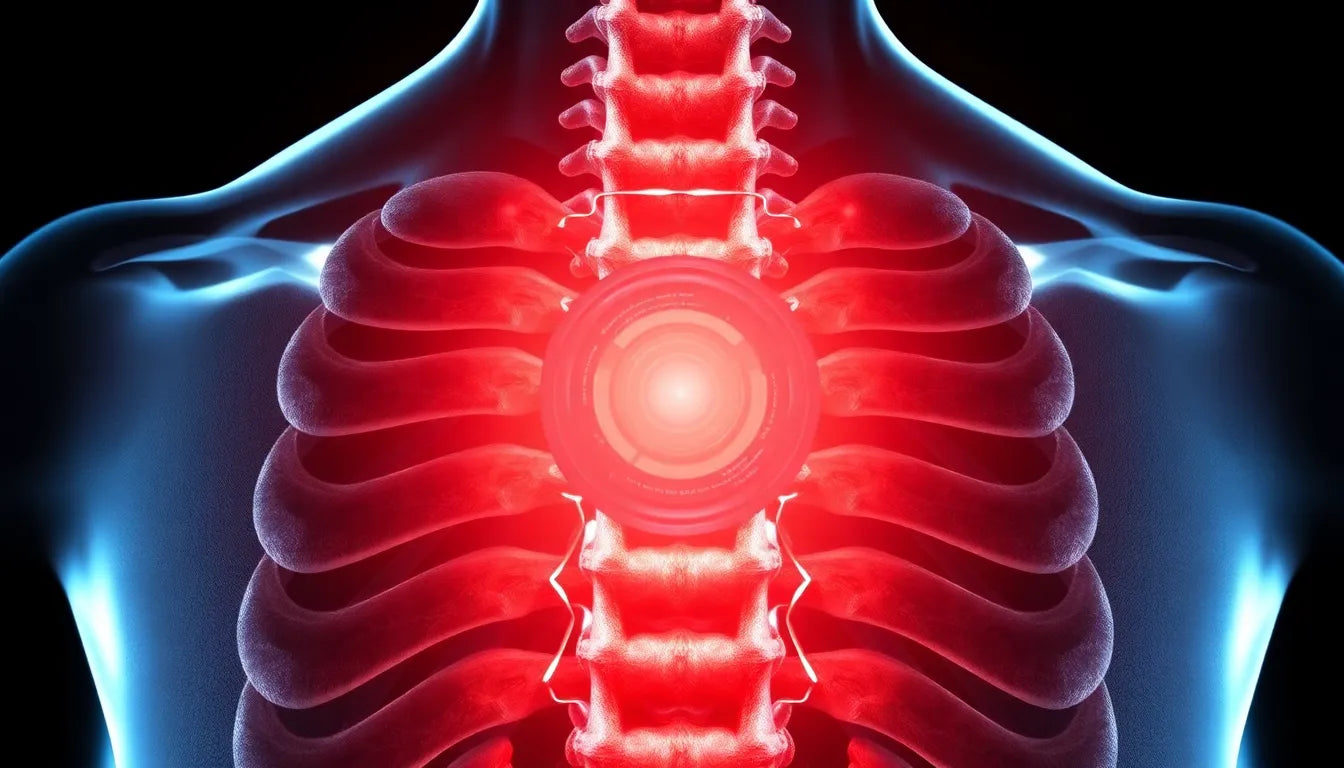Back pain is a pervasive issue that affects millions of people worldwide, often stemming from conditions like a herniated disc. Among the various types of herniated discs, the paramedian herniated disc stands out due to its unique characteristics and the specific challenges it presents. Understanding this condition is crucial for managing its symptoms and improving quality of life.
What is a paramedian herniated disc?
A paramedian herniated disc occurs when the disc material protrudes just lateral to the center of the spinal canal. Unlike a median herniation, which is centrally located, a paramedian herniation is slightly off-center. This positioning can lead to distinct symptoms, primarily due to its impact on the spinal nerves. The location of the herniation often results in unilateral nerve root compression, meaning it affects one side of the body more than the other. This can cause pain, tingling, or weakness, typically following a specific nerve distribution.
The significance of understanding herniated disc types
Recognizing the specific type and location of a herniated disc is essential for effective treatment and management. Each type of herniation can present unique symptoms and require different therapeutic approaches. For instance, a paramedian herniated disc may necessitate targeted interventions to address the one-sided symptoms it causes. By identifying the precise nature of the herniation, healthcare providers can tailor treatment plans to better alleviate symptoms and prevent further complications.
As we delve deeper into the topic, it becomes evident that a comprehensive understanding of paramedian herniated discs can significantly influence treatment outcomes. In the sections that follow, we will explore the causes, symptoms, and various treatment options available for managing this specific type of herniated disc. This knowledge is vital for anyone experiencing back pain or discomfort, as it empowers them to seek the most appropriate care and take proactive steps in their recovery journey.
Causes and risk factors of paramedian herniated disc
The development of a paramedian herniated disc is often attributed to several underlying causes, with disc degeneration being one of the most common. As we age, the spinal discs naturally lose water content, becoming less flexible and more prone to damage. This degeneration can lead to the disc material bulging or rupturing, particularly in the paramedian region, just off the center of the spinal canal. Injuries, such as those resulting from heavy lifting or sudden, awkward movements, can also precipitate a herniation.
Beyond these causes, certain risk factors can increase the likelihood of developing a paramedian herniated disc. Poor posture, often exacerbated by prolonged sitting or improper ergonomics, places additional stress on the spine, potentially leading to herniation. Repetitive strain from activities that involve frequent bending or twisting can also contribute. Moreover, lifestyle factors such as obesity, smoking, and a sedentary lifestyle further elevate the risk by weakening the spinal structure and reducing overall disc health.
Symptoms and diagnosis of paramedian herniated disc
The symptoms associated with a paramedian herniated disc are primarily due to unilateral nerve root compression. This means that the symptoms typically manifest on one side of the body, following the distribution of the affected nerve. Common signs include localized pain that radiates down the arm or leg, tingling sensations, numbness, and muscle weakness. These symptoms can vary in intensity, often worsening with certain movements or positions.
Paramedian herniated discs can be distinguished from other types of herniations, such as median or foraminal, by the specific pattern of symptoms they produce. While median herniations may cause bilateral symptoms or affect the spinal cord, paramedian herniations are more likely to result in one-sided issues. Diagnostic imaging, such as MRI or CT scans, plays a crucial role in accurately identifying the location and severity of the herniation, enabling healthcare providers to tailor treatment plans effectively.
Treatment options for paramedian herniated disc
When it comes to managing a paramedian herniated disc, a range of treatment options are available, starting with conservative approaches. Physical therapy is often recommended to strengthen the muscles supporting the spine, improve flexibility, and relieve pressure on the affected nerve. Rest and anti-inflammatory medications can also help reduce pain and inflammation in the initial stages.
For cases where conservative treatments fail to provide adequate relief, surgical intervention may be considered. Surgical options typically focus on decompressing the affected nerve and alleviating symptoms. Anterior and posterior decompression techniques are among the common surgical approaches, with the choice depending on the specific characteristics of the herniation and the patient's overall health. A thorough evaluation by a spine specialist is essential to determine the most appropriate course of action.
In summary, understanding the causes, symptoms, and treatment options for a paramedian herniated disc is crucial for effective management and recovery. By recognizing the unique aspects of this condition, individuals can seek timely medical attention and pursue strategies that address their specific needs, ultimately improving their quality of life.
Prevention and management of paramedian herniated disc
Preventing a paramedian herniated disc involves adopting lifestyle changes and ergonomic strategies to maintain spinal health. Ensuring proper posture, especially during prolonged sitting or standing, is crucial. Ergonomic aids, such as those offered by Anodyne, can provide support and help maintain correct spinal alignment, reducing strain on the discs.
Regular physical activity is also vital in preventing disc herniation. Engaging in exercises that strengthen the core muscles can support the spine and reduce the risk of injury. Activities like swimming, walking, and yoga are excellent choices for maintaining flexibility and strength without putting excessive pressure on the spine.
For those already experiencing symptoms, effective management is key to preventing further injury. Utilizing ergonomic aids in daily activities, such as supportive chairs and standing desks, can alleviate symptoms and promote recovery. Additionally, learning proper lifting techniques and avoiding repetitive strain can prevent exacerbation of the condition.
Conclusion
Understanding the specific characteristics of a paramedian herniated disc is essential for effective management and treatment. By identifying the unique symptoms and risk factors associated with this type of herniation, individuals can take proactive steps to avoid further complications. Early diagnosis and tailored treatment plans significantly improve outcomes, allowing individuals to maintain a better quality of life.
With the right knowledge and resources, such as those provided by Anodyne, individuals can manage their condition effectively and prevent future occurrences. By prioritizing spinal health and adopting preventive measures, the challenges posed by paramedian herniated discs can be significantly reduced.
Frequently Asked Questions
What is a paramedian herniated disc?
A paramedian herniated disc is a type of disc herniation where the disc material protrudes slightly off-center in the spinal canal, often causing one-sided symptoms due to unilateral nerve root compression.
How is a paramedian herniated disc different from other types?
Unlike median herniations that affect the central spinal canal, paramedian herniations primarily affect one side, leading to unilateral symptoms such as pain, tingling, and weakness.
What are the common symptoms of a paramedian herniated disc?
Common symptoms include one-sided pain, tingling, and weakness, typically following a specific nerve root distribution. These symptoms can vary in intensity and may worsen with certain movements or positions.
When should I seek medical attention for a herniated disc?
Seek medical care if symptoms radiate to limbs, cause significant weakness, or if there are changes in bowel or bladder function, as these may indicate a more serious condition requiring immediate attention.
What are the treatment options for a paramedian herniated disc?
Treatment ranges from conservative methods like physical therapy and medications to surgical interventions for severe cases. The choice of treatment depends on the severity of symptoms and the overall health of the patient.
Sources
- Miami Neuroscience Center. "General Herniated Disc Symptoms by Region."
- Deuk Spine Institute. "Conservative Management and Surgical Indications for Lumbar Herniated Discs."
- Barrow Neurological Institute. "Thoracic Disc Herniation with a Focus on Neurological Presentations."
- Inselspital Bern Neurosurgery. "Detailed Explanation of Paramedian Disc Herniation."
- Penn Medicine. "General Patient-Focused Information on Herniated Disc Disorders."
- Cleveland Clinic. "Herniated Disk Overview."
- Mayo Clinic. "Herniated Disk: Symptoms and Causes."
- American Association of Neurological Surgeons (AANS). "Herniated Disc."


















